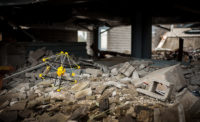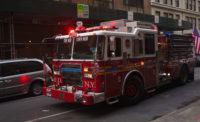Squishy Robotics unveils mobile sensor robots that detect hazards and increase safety for first responders and the public
Company’s rapidly deployable sensor robots are airdropped from drones and helicopters, providing situational awareness and mitigating hazards during disasters and emergencies

When every second counts during emergencies such as wildfires, chemical spills, and environmental or natural disasters, getting first responders to the disaster to assess the situation is critical, but can take precious time. Squishy Robotics, Inc.’s air-deployable, shape-shifting sensor robots—coming out of the elite Berkeley SkyDeck accelerator—provide life-saving situational awareness about chemical, biological, radiological, nuclear, or explosive (CBRNE) threats so first responders and the public can make crucial decisions faster. Shaped like a geodesic ball, the Squishy Robots are equipped with six cameras, GPS, and various interchangeable chemical, biological, and radiological sensors that deliver data and 360-degree videos in situations where human access can be difficult or unsafe. For the first time, Squishy Robotics is making its shape-shifting robots available for pre-sale through its website, with product being delivered by the end of the year.
A spin-off of NASA research, when dropped 400-foot from a drone or 600-feet from a helicopter, the lightweight yet strong sensor robots can quickly provide first responders and HazMat teams with data from the ground, eliminating the need for responders to enter risky environments and reducing their exposure to unknown hazards. The company has created both stationary and mobile robots; the mobile version—still in beta—is capable of being remotely controlled to travel over uneven ground.
“Our Squishy Robots are very compliant, meaning they are designed to take the force from a fall and not get damaged, and offer the situational awareness that is essential for first responders,” explained Dr. Alice Agogino, co-founder and CEO, Squishy Robotics, Inc. and a professor of Mechanical Engineering at UC Berkeley. “We have a solution for the urgent, worldwide need to improve efficiency and increase the safety of emergency responders and the public. Over the last 20 years, 400 first responders have died going into dangerous situations. Our sensor-equipped robots can make a tremendous difference for these brave people by saving lives, reducing costs, and increasing overall effectiveness of emergency response teams.”
The company has signed collaboration agreements with preeminent first responder teams, such as the Los Angeles County Fire Department (LACoFD) and the Houston Fire Department (HFD), the largest fire departments in California and Texas, respectively. Both Departments have agreed to beta test the robots, providing feedback and recommendations that will help refine the Stationary and Mobile robots. LACoFD training and testing is taking place at the Del Valle Regional Training Center where firefighters can test the robots in the “HazMat City” area, practicing with overturned tanker trucks and simulated chemical releases.
What happens in an emergency situation?
Today, first responders use manually positioned sensors to determine the quality of the air and general environment. For situations involving hazardous gases or materials, first responders must first suit up to the maximally safe personal protection equipment (PPE) before going into a dangerous “hot zone” to obtain critical sensor readings that can help responders develop an action plan to mitigate the hazard. This is time-consuming and puts responders in harm’s way. PPE suits are expensive, cumbersome, and physically taxing on the body, and the entire process of suiting-up, walking sensors into and out of a “hot zone,” and decontamination can take more than 90 minutes.
Employing Squishy Robotics new technology, a first responder team can accurately and promptly deliver the robots via remote-piloted drones or helicopters. Once air-dropped, the sensor-enabled robots provide real-time video surveillance and report back on hot zone air quality and the hazard levels. The first responders, located a safe distance away from the danger, monitor the scene with the Squishy Robotics’ user interface (UI) to get the visual and the chemical/biological/radiological concentration readings needed to respond to emergency situations. Artificial intelligence (AI) and machine learning are used to improve data analytics over time and optimize mobility solutions.
About Squishy Robotics
Squishy Robotics, Inc. is a Berkeley SkyDeck accelerator, woman-majority owned startup that has developed both a mobile and a stationary rapidly deployable robot embedded with sensors. The technology is a spin-off of a robot originally developed for NASA space exploration. Squishy Robotics’ sensor robots increase situational awareness and provide the real-time environmental data needed to safely mitigate a hazard, increasing both responder safety and response efficiency. Customizable sensor payloads enable a wide range of applications and are particularly well-suited for large-scale incidents involving CBRNE (chemical, biological, radiological, nuclear, and explosive) materials. For more information, visit https://squishy-robotics.com/ or reach out at info@squishy-robotics.com.
Looking for a reprint of this article?
From high-res PDFs to custom plaques, order your copy today!





